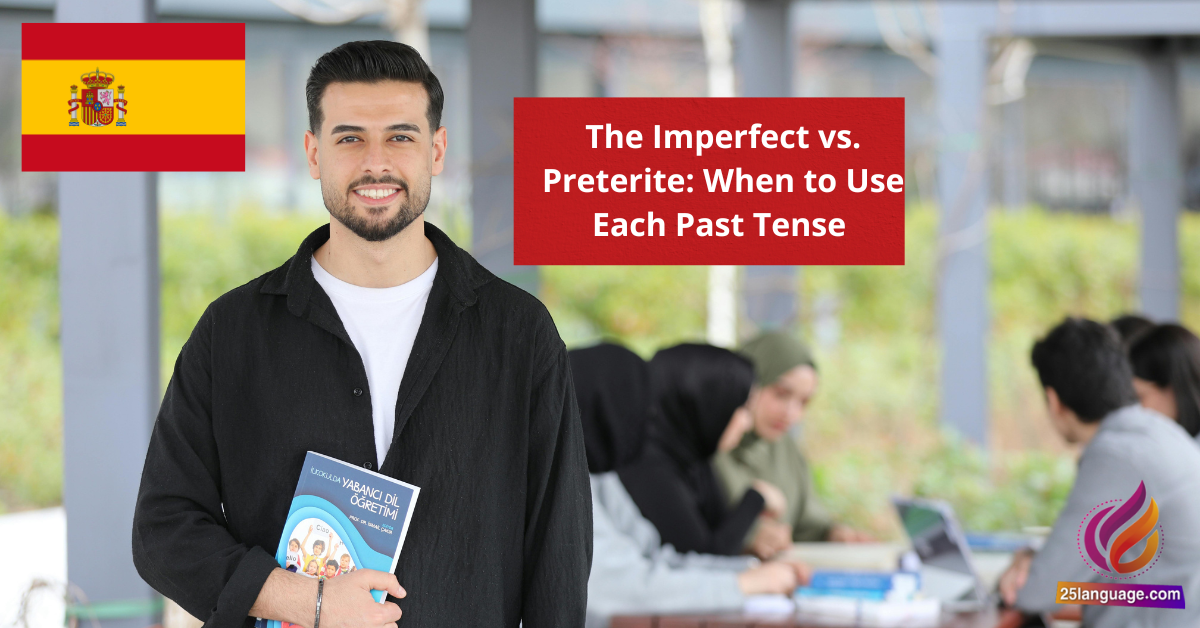The Imperfect vs. Preterite: When to Use Each Past Tense

Imagine telling a story about your childhood adventures-playing outside, learning to ride a bike, or spending time with friends. In Spanish,those memories can be expressed in different ways,depending on the depth and detail you want to convey. Today, we’ll explore the imperfect and preterite tenses, two essential past forms that help you paint vivid pictures of the past. Let’s unlock the secrets to using each tense effectively and enhance your storytelling skills in Spanish!
Understanding the Imperfect and Preterite: mastering Spanish Past Tenses
In Spanish, the two primary past tenses are the imperfect and the preterite, each serving distinct purposes.The imperfect tense is used to describe actions that were ongoing or habitual in the past,while the preterite tense is used for actions that were completed or specific events. When using the imperfect, you might say: Cuando era niño, jugaba al fútbol todos los sábados. (When I was a child, I played soccer every Saturday.) This indicates a routine, suggesting that playing soccer was a regular activity. Conversely, a preterite example would be: Ayer jugué al fútbol con mis amigos. (Yesterday, I played soccer with my friends.) This sentence highlights a specific event that has been completed.
To help differentiate when to use each tense, consider the following key points:
- Imperfect is used for:
- Ongoing actions: Estaba leyendo cuando me llamaste. (I was reading when you called me.)
- Habitual actions: Siempre íbamos a la playa en verano. (We always went to the beach in summer.)
- Preterite is used for:
- Completed actions: Comí pizza anoche. (I ate pizza last night.)
- Specific events: Fui al cine el sábado. (I went to the movies on Saturday.)
| Spanish Example | Rule | English Translation |
|---|---|---|
| Cuando éramos jóvenes, siempre viajábamos. | Imperfect: habitual action | When we were young, we always traveled. |
| Hoy compré un coche. | Preterite: completed action | Today I bought a car. |
| Mientras estudiaba, escuchaba música. | Imperfect: simultaneous ongoing actions | While I was studying,I was listening to music. |
| El año pasado viajé a España. | Preterite: specific event | Last year, I traveled to Spain. |
Navigating Past Narratives: When to Choose Imperfect or Preterite
In Spanish, the choice between the imperfect and the preterite tense can significantly alter the meaning of a narrative. The imperfect tense is used primarily for background information, ongoing actions, or descriptions in the past. It indicates that an action was habitual or continuous without specifying the start or the end. Such as, one might say, “Cuando era niño, jugaba en el parque.” (When I was a child, I played in the park.) This sentence implies that playing in the park was a common activity during childhood. Contrastingly, the preterite tense is employed for completed actions that are viewed as a whole or for specific events that occurred at a particular point in time. An illustrative sentence would be, “Ayer jugué en el parque.” (Yesterday,I played in the park.) here,the preterite emphasizes the action as a single event that happened yesterday.
Key distinctions between the two tenses can be summarized as follows:
- Imperfect: Describes ongoing past actions or habitual routines.
- preterite: Refers to completed actions that occurred at a specific moment.
| Spanish Example | Rule | English Translation |
|---|---|---|
| Siempre íbamos a la playa en verano. | Imperfect: habitual action | We always went to the beach in summer. |
| El año pasado fuimos a la playa. | Preterite: completed action | Last year, we went to the beach. |
| Cuando ella tenía diez años,tenía un perro. | Imperfect: ongoing description | When she was ten years old, she had a dog. |
| El perro se escapó el sábado. | Preterite: specific event | The dog escaped on Saturday. |
Past Events Unveiled: Distinguishing Between Imperfect and Preterite Tenses
In Spanish, the distinction between the imperfect and preterite tenses is crucial for accurately conveying the timing and nature of past events. The imperfect tense is used to describe actions that were ongoing or habitual in the past. It frequently enough sets the scene or provides background information.For example,”Cuando era niño,jugaba en el parque todos los días” translates to “When I was a child,I played in the park every day.” This demonstrates a regular, repeated action in the past. Key phrases that might indicate the use of the imperfect include:
- siempre (always)
- cada día (every day)
- mientras (while)
On the other hand, the preterite tense is employed for actions that are viewed as completed or specific occurrences in the past. It is indeed frequently enough used to tell stories or report events. As an example, “Ayer, comí en un restaurante nuevo” means “Yesterday, I ate at a new restaurant.” This indicates a single, finished action. Look for time indicators that signal the preterite, such as:
- ayer (yesterday)
- una vez (onc)
- el año pasado (last year)
| Spanish Example | Rule/tense | English Translation |
|---|---|---|
| Cuando era niño, jugaba. | Imperfect | When I was a child, I played. |
| Ayer, comí en un restaurante. | Preterite | Yesterday, I ate at a restaurant. |
| Siempre íbamos a la playa en verano. | Imperfect | We always went to the beach in summer. |
| El año pasado,viajé a España. | Preterite | Last year, I traveled to Spain. |
Practical Insights into Imperfect and Preterite: Enhancing Your Spanish Fluency
In Spanish, the imperfect tense is used to describe ongoing or habitual actions in the past, as well as background situations. This tense frequently enough focuses on the context rather than the action itself or its completion. Key aspects of the imperfect include:
- Describing habitual actions: yo jugaba al fútbol cada semana. (I played soccer every week.)
- Setting a scene or describing background conditions: Era un día soleado y hacía calor. (It was a sunny day and it was warm.)
- Indicating age or time in the past: Teníamos diez años. (We were ten years old.)
Conversely, the preterite tense is used for actions that were completed at a specific point in time. this tense highlights individual actions rather than continuous activity. Meaningful features of the preterite include:
- Actions completed in the past: Ayer compré un coche nuevo. (I bought a new car yesterday.)
- Specific moments or events: La semana pasada fuimos al cine. (Last week we went to the movies.)
- Actions that occurred a defined number of times: visitamos España tres veces. (We visited Spain three times.)
| Spanish Example | Tense | English Translation |
|---|---|---|
| Yo hablaba con ella todos los días. | Imperfect | I talked to her every day. |
| Comimos en ese restaurante anoche. | Preterite | We ate in that restaurant last night. |
| Siempre veía la televisión por la tarde. | Imperfect | I always watched television in the afternoon. |
| Ella llegó a las cinco. | Preterite | She arrived at five o’clock. |
In Summary
¡Excelente trabajo al concluir esta lección sobre el imperfecto y el pretérito! hoy hemos explorado las diferencias clave entre estos dos tiempos pasados en español. Recordemos que el pretérito se utiliza para acciones específicas y concluidas, mientras que el imperfecto se enfoca en acciones habituales, descripciones y situaciones prolongadas en el pasado.
Comprender cuándo usar cada uno de estos tiempos es esencial para comunicar tus experiencias de manera efectiva. Te animo a practicar estos conceptos en tu vida diaria. Ya sea narrando una historia, contando anécdotas a amigos o escribiendo un diario, intenta incorporar tanto el imperfecto como el pretérito. Con el tiempo y la práctica, te volverás más seguro y fluido en su uso.
No olvides que aprender un nuevo idioma es un viaje. Cada lección es un paso más hacia tu dominio del español. ¡Sigue adelante! ¡Tú puedes!





























